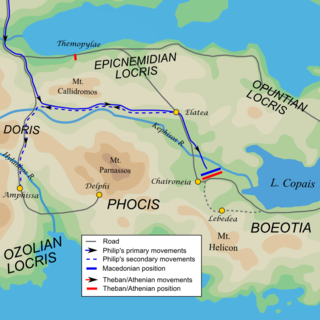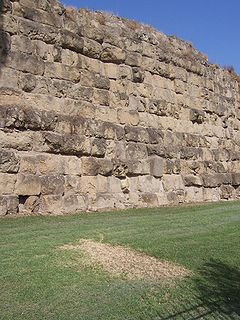Related Research Articles
Andocides was a logographer in Ancient Greece. He was one of the ten Attic orators included in the "Alexandrian Canon" compiled by Aristophanes of Byzantium and Aristarchus of Samothrace in the third century BC.
This article concerns the period 399 BC – 390 BC.
Year 403 BC was a year of the pre-Julian Roman calendar. At the time, it was known as the Year of the Tribunate of Mamercinus, Varus, Potitus, Iullus, Crassus and Fusus. The denomination 403 BC for this year has been used since the early medieval period, when the Anno Domini calendar era became the prevalent method in Europe for naming years.

Year 338 BC was a year of the pre-Julian Roman calendar. At the time it was known as the Year of the Consulship of Camillus and Maenius. The denomination 338 BC for this year has been used since the early medieval period, when the Anno Domini calendar era became the prevalent method in Europe for naming years.
Year 415 BC was a year of the pre-Julian Roman calendar. At the time, it was known as the Year of the Tribunate of Cossus, Vibulanus, Volusus and Cincinnatus. The denomination 415 BC for this year has been used since the early medieval period, when the Anno Domini calendar era became the prevalent method in Europe for naming years.
Year 391 BC was a year of the pre-Julian Roman calendar. At the time, it was known as the Year of the Tribunate of Flavus, Medullinus, Camerinus, Fusus, Mamercinus and Mamercinus. The denomination 391 BC for this year has been used since the early medieval period, when the Anno Domini calendar era became the prevalent method in Europe for naming years.
Year 354 BC was a year of the pre-Julian Roman calendar. At the time, it was known as the Year of the Consulship of Ambustus and Crispinus. The denomination 354 BC for this year has been used since the early medieval period, when the Anno Domini calendar era became the prevalent method in Europe for naming years.

The gens Fabia was one of the most ancient patrician families at ancient Rome. The gens played a prominent part in history soon after the establishment of the Republic, and three brothers were invested with seven successive consulships, from 485 to 479 BC, thereby cementing the high repute of the family. Overall, the Fabii received 45 consulships during the Republic. The house derived its greatest lustre from the patriotic courage and tragic fate of the 306 Fabii in the Battle of the Cremera, 477 BC. But the Fabii were not distinguished as warriors alone; several members of the gens were also important in the history of Roman literature and the arts.

The Servian Wall was an ancient Roman defensive barrier constructed around the city of Rome in the early 4th century BC. The wall was built of volcanic tuff and was up to 10 m (33 ft) in height in places, 3.6 m (12 ft) wide at its base, 11 km (6.8 mi) long, and is believed to have had 16 main gates, of which only one or two have survived, and enclosed a total area of 246 hectares. In the 3rd century AD it was superseded by the construction of the larger Aurelian Walls as the city of Rome grew beyond the boundary of the Servian Wall.

The work called Ab urbe condita, sometimes referred to as Ab urbe condita libri, is a monumental history of ancient Rome, written in Latin between 27 and 9 BC by Livy, a Roman historian. The work covers the period from the legends concerning the arrival of Aeneas and the refugees from the fall of Troy, to the city's founding in 753 BC, the expulsion of the Kings in 509 BC, and down to Livy's own time, during the reign of the emperor Augustus. The last event covered by Livy is the death of Drusus in 9 BC. 35 of 142 books, about a quarter of the work, are still extant. The surviving books deal with the events down to 293 BC, and from 219 to 166 BC.

Lars Tolumnius was the most famous king of the wealthy Etruscan city-state of Veii, roughly ten miles northwest of Rome, best remembered for instigating a war with Rome that ended in a decisive Roman victory.

Brennus was a chieftain of the Senones. He defeated the Romans at the Battle of the Allia. Later that year, he led an army of Cisalpine Gauls in their attack on Rome and captured most of the city, holding it for several months. Brennus's sack of Rome was the only time in 800 years the city was occupied by a non-Roman army before the fall of the city to the Visigoths in 410 AD.
Marcus Fabius Ambustus was Pontifex Maximus of the Roman Republic in the year that Rome was taken by the Gauls of Brennus, 390 BC. His three sons--Caeso, Numerius, and Quintus—were sent as ambassadors to the Gauls, when the latter were besieging Clusium, and participated in an attack against the besieging Gauls. The Gauls demanded that the Fabii should be surrendered to them for violating the law of nations; and upon the senate refusing to give up the guilty parties, they marched against Rome, which they sacked after the battle of the Allia. The three sons were in the same year elected consular tribunes.
Caeso Fabius Ambustus was a four-time consular tribune of the Roman Republic around the turn of the 5th and 4th centuries BC.

The New Jersey Museum of Transportation is a museum dedicated to the collection, preservation, and operation of historic railroad equipment. The organization runs excursion trains on a 3 ft narrow gauge tourist railroad named the Pine Creek Railroad. The museum is independently operated along with the Allaire Village and is located in Allaire State Park in New Jersey. The museum runs Easter Bunny Express trains in April, Haunted Halloween trains in October, and Santa Special trains on the weekends in December.
The Roman conquest of the Hernici, an ancient Italic people, took place during the 4th century BC. For most of the 5th century BC, the Roman Republic had been allied with the other Latin states and the Hernici to successfully fend off the Aequi and the Volsci. In the early 4th century BC, this alliance fell apart. A war fought between Rome and the Hernici in the years 366 - 358 BC ended in Roman victory and the submission of the Hernici. Rome also defeated a rebellion by some Hernician cities in 307 - 306 BC. The rebellious Hernici were incorporated directly into the Roman Republic, while those who had stayed loyal retained their autonomy and nominal independence. In the course of the following century, the Hernici became indistinguishable from their Latin and Roman neighbours and disappeared as a separate people.

The overthrow of the Roman monarchy is an event in ancient Rome that took place between the 6th and 5th centuries BC where a political revolution replaced the then-existing Roman monarchy under Lucius Tarquinius Superbus with a republic. The details of the event were largely forgotten by the Romans a few centuries later; later Roman historians invented a narrative of the events, traditionally dated to c. 509 BC, but largely believed to be fictitious by modern scholars.
Marcus Fabius Vibulanus was consul of the Roman republic in 442 BC and consular tribune in 433 BC.
Lucius Valerius Potitus was a five time consular tribune, in 414, 406, 403, 401 and 398, and two times consul, in 393 and 392 BC, of the Roman Republic.
Quintus Servilius Fidenas was a prominent early Roman politician who achieved the position of Consular tribune six times throughout a sixteen-year period. Quintus Servilius was a member of the illustrious gens Servilia, a patrician family which had achieved great prominence since the foundation of the republic. In particular, Servilius was the son of Quintus Servilius Priscus Fidenas, a well respected statesman and general who served as dictator twice, in 435 and 418 BC, as well as holding the religious title of either augur or pontifex, which he held until his death in 390 BC. Servilius the younger himself had at least one son, also named Quintus Servilius Fidenas, who served as consular tribune in 382, 378, and 369 BC.
References
- ↑ Humm, Michel (September 19, 2014), Mineo, Bernard (ed.), "From 390 bc to Sentinum: Political and Ideological Aspects", A Companion to Livy, Hoboken, NJ, USA: John Wiley & Sons, Inc, pp. 342–366, doi:10.1002/9781118339015.ch26, ISBN 978-1-118-33901-5 , retrieved July 4, 2022
- ↑ Forsythe, Gary (September 19, 2014), Mineo, Bernard (ed.), "The Beginnings of the Republic from 509 to 390 bc", A Companion to Livy, Hoboken, NJ, USA: John Wiley & Sons, Inc, pp. 314–326, doi:10.1002/9781118339015.ch24, ISBN 978-1-118-33901-5 , retrieved July 4, 2022
- ↑ "Andocides | Encyclopedia.com". www.encyclopedia.com. Retrieved July 4, 2022.